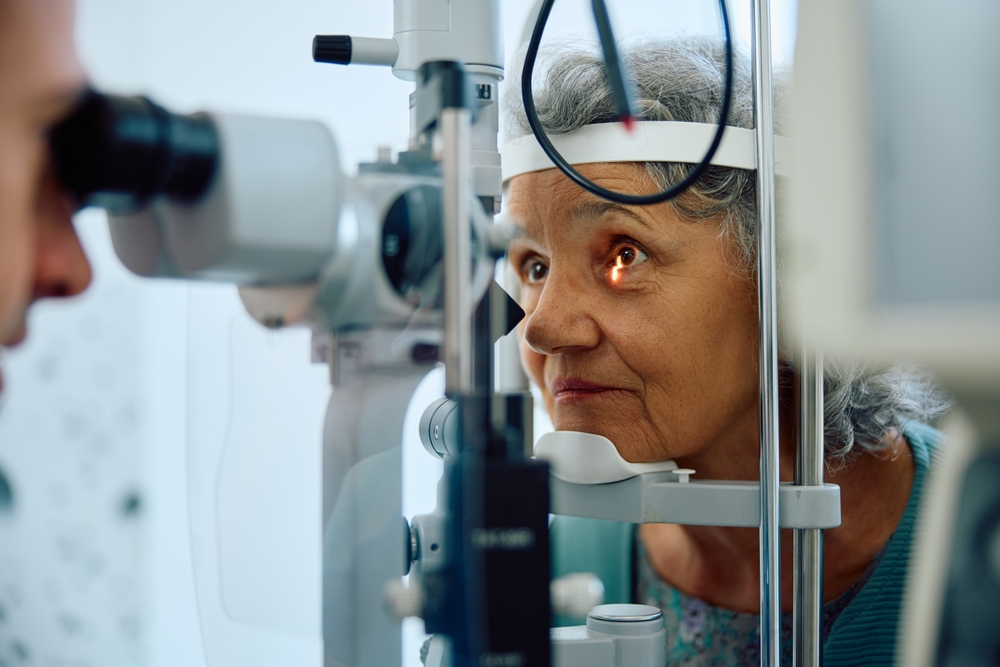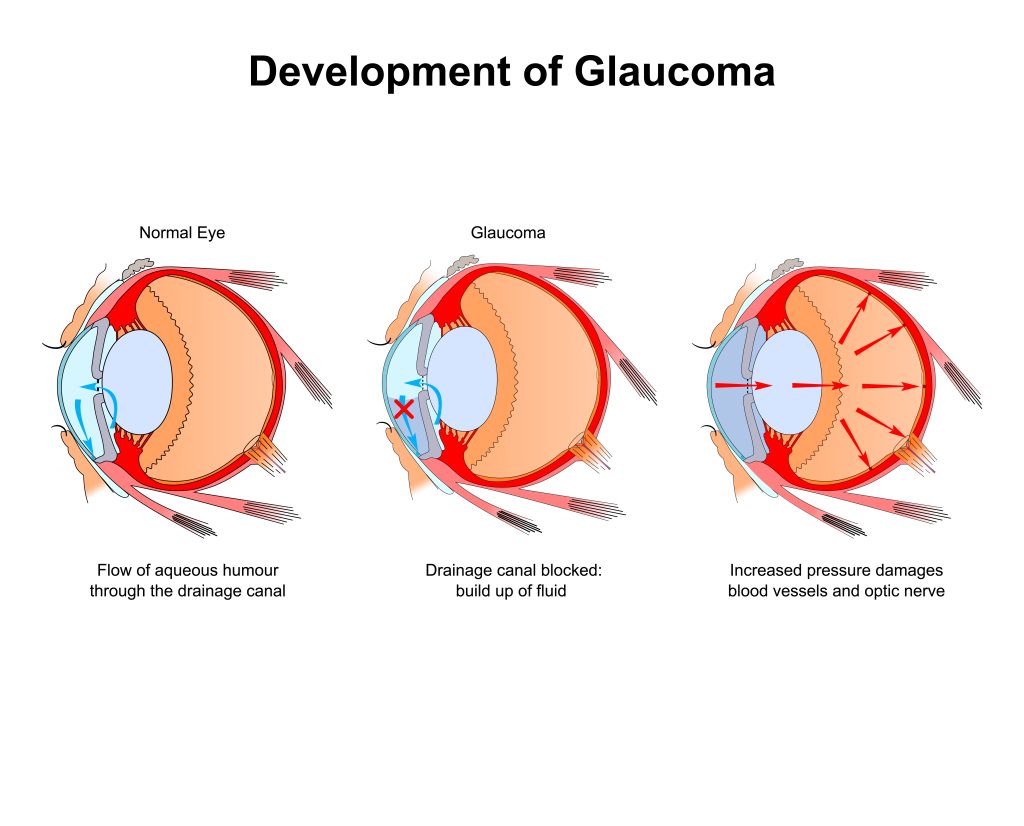Home » Blog » Can You Treat Glaucoma?
Can You Treat Glaucoma?
Posted by: Georgia Eye Partners in Eye Health

Have you or someone you love recently received a diagnosis of glaucoma? You’re not alone.
Glaucoma is a highly common age-related eye condition and is the leading cause of blindness in adults over the age of 60. When you experience vision loss from glaucoma, it’s unfortunately impossible to regain that vision again.
All vision loss as a result of glaucoma is permanent, as it’s irreversible. However, one of the things that makes glaucoma more challenging to diagnose is there are few early symptoms.
If you’re not regularly scheduling eye exams with your eye doctor, diagnosing the eye condition becomes far more challenging until you’ve already lost vision. For that reason, glaucoma is often referred to as the Silent Thief of Sight.
Another reason glaucoma is a challenging eye condition is it doesn’t have a cure. Fortunately, it is a treatable and manageable eye condition.
Although treatment cannot reverse any damage to your vision or eyes, it can prevent further vision loss. This is why it’s essential to schedule eye exams regularly with your eye doctor as an eye exam is the only way to detect and diagnose glaucoma.
An early diagnosis may save you from vision loss from the eye condition. Keep reading to learn more about glaucoma and how to treat it.
What is Glaucoma?

Glaucoma is a serious eye condition that can lead to vision loss if it’s not treated or diagnosed. To effectively manage glaucoma and protect your eyesight, you must clearly understand the condition and how it affects your vision.
Knowing the basics of glaucoma makes treating it easiest. You can work with your eye doctor to find the best treatment plan.
Glaucoma is the name given to a group of eye conditions that all cause damage to the optic nerve. The optic nerve connects your eye to the neural pathways in your brain.
Without it, your brain couldn’t know what you see. When it becomes significantly damaged, it’s unable to send complete information to your brain, causing visual problems. If the damage is extensive enough, it can cause total vision loss.
For most patients, glaucoma occurs because of a buildup in intraocular pressure. Aqueous fluid flows in and out of the eye to keep it healthy.
But pressure builds inside the eye when this fluid can’t drain properly. When the pressure is high, it strains the optic nerve, eventually damaging it.
Open-Angle Glaucoma
The most common form of glaucoma is open-angle glaucoma, which occurs when fluid cannot drain through the primary drainage angle properly.
The primary drainage angle is the gap between the cornea and the iris. However, the other drainage channels around the eye, called the trabecular meshwork, are blocked off.
This form of glaucoma causes a prolonged and gradual increase in intraocular pressure, which is built into the condition. It can take years for any noticeable visual symptoms to manifest, but when they appear, they cannot be fixed and are permanent.
What are the Symptoms of Glaucoma?
Most forms of glaucoma don’t show any symptoms in the early stages of the condition. However, signs of glaucoma can be detected during an eye exam with your eye doctor.

Your eye doctor can measure your intraocular pressure levels. If these levels are elevated, this is usually a sign that you are at risk for developing glaucoma if you haven’t already.
Your eye doctor can also examine your optic nerve with specialized imaging equipment to see if there is any sign of damage. There are often signs of damage well before you develop any noticeable glaucoma symptoms, like vision loss.
When you do develop glaucoma symptoms, they often begin with blurry peripheral vision. As glaucoma worsens, you may lose all of your peripheral vision. In the most advanced stages of glaucoma, you’ll experience tunnel vision.
How to Receive the Most Effective Glaucoma Treatment
Ideally, you should receive glaucoma treatment before you experience vision loss. The best and most effective way to receive early treatment is to schedule eye exams regularly with your eye doctor.
You should have eye exams more often if you know you’re considered at an increased risk of developing glaucoma. You’re at higher risk for glaucoma if you:
- Are over 60
- Are African American, Hispanic, or of Asian heritage, and over 40
- Have a family history of glaucoma
- Have a high refractive error
- Have certain medical conditions like high blood pressure, heart disease, or diabetes
- Take corticosteroid medications for an extended time
- Having thin corneas
- Having high intraocular pressure
All adults over 55 should have an eye exam every year. But if you’re at especially high risk for glaucoma, you may need eye exams more often.
Your eye doctor will be able to tell you just how often you need to have your eyes examined. Follow their recommendations, and you can ensure you have your glaucoma diagnosed and treated as soon as possible.
Glaucoma Treatment
There are many forms of glaucoma treatment. Although none of these treatments can reverse vision loss, they can significantly slow it down and even prevent it.
What treatment or treatments you need depends on your unique case and its severity. Your eye doctor will determine the appropriate treatment plan. Treatments available at Georgia Eye Partners include:
Eye Drops to Control Intraocular Pressure
Prescription eye drops are usually the first treatment given to glaucoma patients. These eye drops reduce fluid production and help fluid drain better.
They need to be taken daily to effectively reduce intraocular pressure. Your eye doctor may also prescribe these drops if you have high intraocular pressure, even if you haven’t developed glaucoma yet.
Laser Procedures
Several kinds of laser procedures can help lower intraocular pressure to treat glaucoma.
Laser Trabeculoplasty
Laser trabeculoplasty is a treatment that uses a laser to open up the trabecular meshwork and increase the flow of fluid from the eye. There are two types of laser trabeculoplasty: Argon Laser Trabeculoplasty (ALT) and Selective Laser Trabeculoplasty (SLT). SLT can be repeated, while ALT cannot, but it is often effective even after only one use.
Minimally Invasive Glaucoma Surgeries (MIGS)
MIGS procedures are less invasive forms of other microsurgeries. They are often designed to be performed at the same time as cataract surgery to minimize the amount of surgery and recovery time a patient needs. They are best suited for patients with mild to moderate glaucoma, as more severe glaucoma usually requires traditional microsurgery.
Trabeculectomy
A trabeculectomy is a procedure that creates a new opening in the white part of the eye (sclera) to act as an extra drainage channel.
Tube Shunt
A tube shunt procedure is suitable for patients who don’t respond well to trabeculectomy or tend to develop scar tissue. It inserts a drainage device called a shunt with a silicone pouch to help drain fluid from the eye.
Why Eye Exams are Important

Glaucoma requires prompt diagnosis and treatment to avoid permanent vision loss. However, most people don’t realize they have the eye condition until they’ve already suffered irreversible vision loss.
This is what makes eye exams with your eye doctor so crucial. During a comprehensive eye exam, your eye doctor can detect any signs of glaucoma, even if you don’t have any symptoms of the eye condition.
Your eye doctor will measure your intraocular pressure, examine your optic nerve, and assess your visual field. If they suspect you could have glaucoma, they may perform additional tests before confirming their diagnosis and determining the best treatment.
Managing Glaucoma and Necessary Lifestyle Changes
Because glaucoma has no cure, managing the eye condition is necessary. This takes a combination of treatments and lifestyle changes.
In addition to taking all prescribed treatments and following any recommendations from your eye doctor, you can support your eye health in other ways, like:
Eat a Healthy Diet
Eating a diet rich in fruits, vegetables, and omega-3 fatty acids has been shown to help support eye health.
Stay Active
Exercise regularly, whether running, walking, swimming, or doing yoga with your grandchildren. Staying active can make a big difference and can help you feel better!
Don’t Smoke
If you’re a smoker, quitting is one of the best things you can do for your eyes and your body. Talk to your doctor if you’re struggling with quitting.
Working with your eye doctor and adopting a healthy lifestyle is an excellent way to manage glaucoma and preserve your vision. Having this eye condition doesn’t have to mean the end of seeing the world around you.
Do you need to treat glaucoma? Take the first step by requesting your appointment today at Georgia Eye Partners in Atlanta, GA!